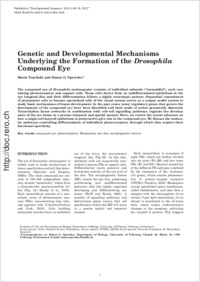Genetic and developmental mechanisms underlying the formation of the Drosophila compound eye
- Tsachaki, Maria Department of Biology, University of Fribourg, Switzerland
- Sprecher, Simon G. Department of Biology, University of Fribourg, Switzerland
-
15.12.2011
Published in:
- Developmental Dynamics. - 2012, vol. 241, no. 1, p. 40–56
English
The compound eye of Drosophila melanogaster consists of individual subunits (“ommatidia”), each containing photoreceptors and support cells. These cells derive from an undifferentiated epithelium in the eye imaginal disc and their differentiation follows a highly stereotypic pattern. Sequential commitment of pluripotent cells to become specialized cells of the visual system serves as a unique model system to study basic mechanisms of tissue development. In the past years, many regulatory genes that govern the development of the compound eye have been identified and their mode of action genetically dissected. Transcription factor networks in combination with cell–cell signalling pathways regulate the development of the eye tissue in a precise temporal and spatial manner. Here, we review the recent advances on how a single-cell-layered epithelium is patterned to give rise to the compound eye. We discuss the molecular pathways controlling differentiation of individual photoreceptors, through which they acquire their functional specificity.
- Faculty
- Faculté des sciences et de médecine
- Department
- Département de Biologie
- Language
-
- English
- Classification
- Biological sciences
- License
-
License undefined
- Identifiers
-
- RERO DOC 29552
- DOI 10.1002/dvdy.22738
- Persistent URL
- https://folia.unifr.ch/unifr/documents/302571
Statistics
Document views: 139
File downloads:
- pdf: 220
